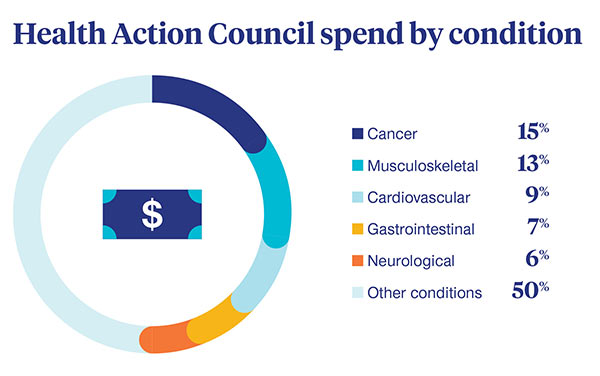In the fifth joint white paper by the Health Action Council and UnitedHealthcare, a comprehensive analysis of 320,000+ covered lives identified 50% of nearly $2 billion in cost to employers was limited to five conditions:
Cancer – 15%
Musculoskeletal – 13%
Cardiovascular – 9%
Gastrointestinal – 7%
Neurological – 6%
The study, Costly Conditions: Identifying and Addressing Top Clinical Cost Drivers, offers insights into why employer healthcare cost varies so widely across gender, age, income, geography and social determinants of health. In addressing these dominant conditions, the report shows why individual communities matter so much in terms of total cost of care, billing patterns, treatments and outcomes.
In addition to the “why,” the report outlines five recommendations for employers to reduce costs by encouraging more employee engagement, including:
- Transparency
Empowering people with more information about their care options may help everyone make more informed decisions and save. Integrated online resources available today provide personalized wellness support, decision-making power and comparison-shopping options for employees.
- Engagement
Encouraging employee engagement – activation – helps optimize plans and incentives. For example, the UnitedHealthcare HAI™ tool evaluates 53 evidence-based decisions as well as life-stage, demographic and social determinants, to identify under-engaged individuals and groups.
- Affordability
Lower drug prices have the greatest impact on plan affordability for the company and employee. Introducing pharmacy step therapies to support the use of high-quality, lower-cost generics or biosimilars before turning to more expensive solutions is one example. Also, look for differences in practice patterns by geographic region (over- and undertreating; low adoption of best practices).
- Advocacy
Employers should also make sure their employee health strategy includes a commitment to helping their employees navigate the healthcare system. Using advanced algorithms to identify the next best actions personalized to each member, advocacy and clinical resources can go beyond basic customer service to develop a deeper understanding of an individual and their needs, including social needs, to deliver personalized guidance.
Although heathcare costs can be challenging for any business, the white paper provides employers with actionable steps on how to address clinical cost drivers to improve employee well-being and lower costs.
Health Action Council is a not-for-profit organization representing large employers to enhance human and economic health through thought leadership, innovative services, and collaboration. UnitedHealthcare is dedicated to helping people nationwide live healthier lives by simplifying the healthcare experience.
This content provided by and paid for by United Healthcare.
To learn more about sponsored content articles, click here or email Tom May at tmay@vbjusa.com.






